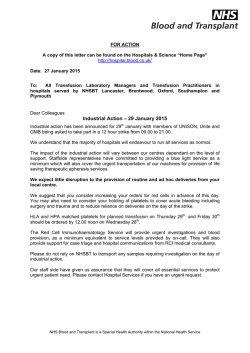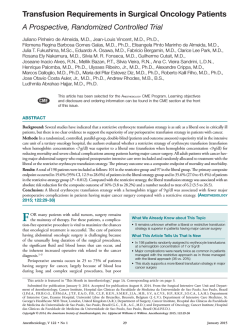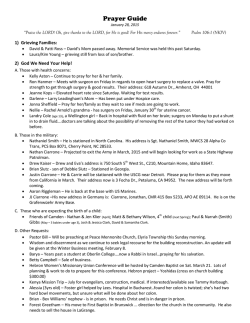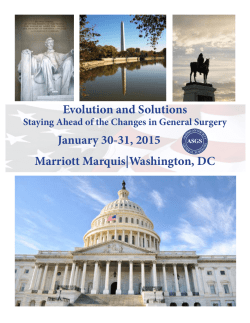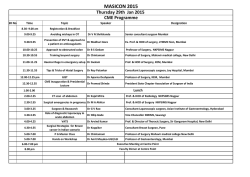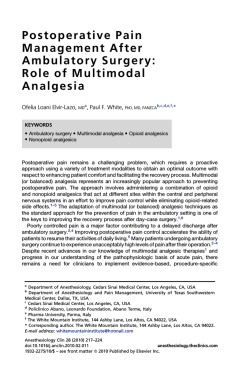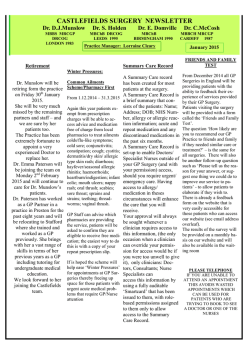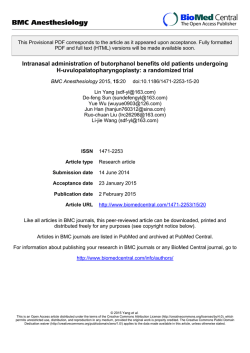
Surgery and Anesthesia in Sickle Cell Disease
From www.bloodjournal.org by guest on February 6, 2015. For personal use only. Surgery and Anesthesia in Sickle Cell Disease By Mabel Koshy, Steven J. Weiner, Scott T. Miller, Lynn A. Sleeper, Elliott Vichinsky, Audrey K. Brown, Yusuf Khakoo, Thomas R. Kinney, and The Cooperative Study of Sickle Cell Disease From 1978 t o 1988, The Cooperative Study of Sickle Cell Disease observed 3,765 patients with a mean follow-up of 5.3 k 2.0 years. One thousand seventy-nine surgical procedures were conducted on 717 patients (77% sickle cell anemia [SS], 14% sickle hemoglobin C disease [SC], 5.7% Spo thalassemia, 39'0Sp+ thalassemia). Sixty-nine percent had a single procedure, 219'0 had t w o procedures, and the remaining 11% had more than t w o procedures during the study follow-up. The most frequent procedure was abdominal surgery for cholecystectomy or splenectomy (2496 of all surgical procedures, N = 258). Of these, 939'0 received blood transfusion, and there was no association between preoperative hemoglobinA level and complication rates (except reduction in pain crisis). Overall mortality within 30 days of a surgical procedure was 1.1% (12 deaths after 1,079 surgical procedures). Three deaths were considered t o be related t o the surgical procedure andlor anesthesia (0.3%). No deaths were reported in patients younger than 14 years of age. Sickle cell disease (SCD)-relatedcomplications after surgery were more frequent in SS patients who received regional compared with general anesthesia (adjusted for risk level of the surgical procedure, patient age, and preoperative transfusion status, P = .058). Non-SCD-related postoperative complications were higher in both SS and SC patients who received regional compared with those who received general anesthesia (P= .095). Perioperative transfusion was associated with a lower rate of SCD-related postoperative complications for SS patients undergoing low-risk procedures (P = .006, adjusted for age and type of anesthesia), with crude rates of 12.9% without transfusion compared with 4.8% with transfusion. In SC patients, preoperative transfusion was beneficial for all surgical risk levels ( P = .0091. Thus, surgical procedures can be performed safely in patients with SCD. 0 1995 by The American Societyof Hematology. P ATIENTS WITH sickle cell disease (SCD; whichinMATERIALSANDMETHODS cludes sickle cell anemia [SS], sickle hemoglobin C Patients disease [SC], and the sickle 0 thalassemias) who undergo The goals, objectives, design, and enrollment procedures of the surgery are generally considered to beat greater risk for Cooperative Study of Sickle Cell Disease have been described elseperioperative complications than otherwise healthy patients where.26-28 From October 1978 to October 1988, 3,765 patients from without this hematologic disorder.'"' Favorable outcomes 23 clinical centers across the continental United States participated have been reported without transfusion, but perioperative in the CSSCD. The median length of patient follow-up was 6.0 transfusion is commonly used to prepare SCD patients for years. Of the total study cohort, 67.5% of the patients had SS, 22.4% surgery and to treat complications of sickle cell d i s e a ~ e . 4 , ~ . ~ ~had " ~ SC, 5.0% had sickle Po thalassemia (Soo thal), and 5.1% had sickle p' thalassemia (So' thal). The Hb phenotype was established Although the optimal level of sickle hemoglobin (Hb) to be by the Centers for Disease Control using standard laboratory achieved is unknown, most sickle cell centers adhere to some methods. form of transfusion protocol for SCD patients undergoing sUrgery.l.18.20-25 The Cooperative Study of Sickle Cell Disease (CSSCD) was a natural history study that observed 3,765 patients from 1978 to 1988.26.27 This report analyzes the course and outcome of the 1,079 surgical procedures performed on 717 patients during this time period. From the University of Illinois, Chicago, IL; New England Research Institutes, Watertown, MA; the Department of Pediatrics, State University of New York Health Science Center at Brooklyn, Brooklyn, NY; the Department of Pediatrics, Children's Hospital, Oakland, CA; the Columbia University College of Physicians and Surgeons and Harlem Hospital Center, New York, NY; the Department of Pediatrics, Duke University Medical Center, Durham, NC. Submitted February 21, 1995; accepted July 3, 1995. Supported by the Division of Blood Diseases and Resources of the National Heart, Lung, and Blood Institute of the National Institutes of Health. Address reprint requests to Mabel Koshy, MD, University of Illinois at Chicago, Division of Hematology (M/C 787), 840 S Wood St, Room 314 CSB, Chicago, IL 60612. The publication costsof this article were defrayedin part by page charge payment. This article must therefore be hereby marked "advertisement" in accordance with 18 U.S.C. section 1734 solely to indicate this fact. 0 1995 by The American Society of Hematology. 0006-4971/95/8610-0012$3.00/0 3676 Data Collection A standardized CSSCD data collection form was completed each time a patient underwent a surgical procedure. Because of limitations in data collection procedures, only one surgical procedure was recorded per operation. Medical history, laboratory data, and perioperative course were recorded on this form. Separate forms were completed documenting blood transfusions and acute and chronic clinical events. Transfusion data for the 30-day period before surgery and acute event data for the 7-day period after surgery were used in this report. All deaths within 30 days after a surgical procedure are summarized in this report. Deaths occurring within 7 days of surgery were defined as postoperative complications. Class$cation of Surgeries, Anesthesia, Transfusion, and Complications Surgeries were definedusing the International Classification of Diseases (9th revision) diagnosis codes for procedures. For the purposes of analysis, surgical procedures were categorized into three groups by level of risk low, moderate, and high.29Low-risk procedures are those of the eyes, skin, nose, ears, and distal extremities as well as those pertaining to the dental, perineal, and inguinal areas (eg, inguinal hernia repair, myringotomy, and dilatation and curettage). Moderate-risk procedures are those of the throat, neck, spine, proximal extremities, genitourinary system, and intra-abdominal areas, such astonsillectomy, Cesarean section, splenectomy, cholecystectomy, and hip replacement. High-risk procedures are those pertaining to the intracranial, cardiovascular, and intrathoracic systems (eg, craniotomy and heart valve replacement). Blood, Vol 86, No 10 (November 15). 1995: pp 3676-3684 From www.bloodjournal.org by guest on February 6, 2015. For personal use only. RISKS OF SURGERY AND ANESTHESIA IN SICKLECELL DISEASE 3677 14.2% (N = 102) were SC, 5.7% (N = 41) were Spathal, and In addition to overall analyses stratifiedby risk level, six specific classes of the most common surgical procedures wereanalyzed (1) 2.9% (N = 21) wereSp+ thal. This group hasproportionately cholecystectomy or splenectomy (N = 222and 36, respectively; more SS and fewer SC and SO+ thal patients than the total 23.9% of all surgical procedures); (2) dilation and curettage (N = CSSCD cohort (see Materials and Methods). Sixty-nine per97; 9.0%); (3) Cesarean section or hysterectomy (N = 87; 8.1%); cent (N = 495) of the patients underwent one, 20.5% (N = (4) tonsillectomyand/oradenoidectomy(N = 46; 4.3%); ( 5 ) hip 147) had two, 6.0% (N = 43) had three, and 4.5% (N = 32) replacement, removal, or revision (N = 4 4 ; 4.1%);and (6) myrinhad four or more surgical procedures during the follow-up gotomy (N = 30; 2.8%). The frequencies of the remaining surgical period. Forty-eight percent (N = 520) of the 1,079 reported procedures (47.8%) are listed in the Appendix. surgical procedures were classified as low-risk, 50% (N = Anesthesia was classified as general, regional, and local. General anesthesia refers to that induced by the inhalationof gas and balanced 543) as moderate-risk, and 2% (N = 16) as high-risk proceintravenous methods. Regional anesthesia refers to spinal, epidural, (N = 806)wereelectiveand dures.Seventy-fivepercent and nerve block anesthesia. The type of anesthesia and its method 25% (N = 271) wereemergent surgicalprocedures. The of administration were not prescribedby the CSSCD protocol. mean age at the timeof surgery was 22.0 2 11.6 years, with Patients were defined as preoperatively transfused if at least one of age, 25% being 10 to 19 transfusion was administered within 30 days before surgery. Postop- 17% being less than 10 years years of age, 52% being20 to 39 yearsof age, and 6% being erative complication ratesfor patients who were perioperatively (ei40 years of age and older. Female patients underwent6 1% therpreoperatively or intraoperatively) transfused were compared with those who were not transfused. Total Hb concentrations and (N = 660) of thesurgicalproceduresandmale patients Hb A percentages presented in this report were obtained after trans- underwent the remaining 39% (N = 419). fusion and before surgery. The CSSCD wasa natural history study, The reported sample includes surgical procedures of difthus noprotocolwasspecified forperioperativemanagement;all fering risk levels performed on patientsof varying ages. The patients were treated according to institutional practices. risk of postoperative complications significantly increased Postoperative complications were definedas complications that with age (estimated odds ratio, 1.3 times increased risk of occurred within7 days after surgery. These complications were catepostoperative complications per10 years of age, P < . m o l ) . gorized into three groups: (1) SCD-related, (2) non-SCD-related, Comparisons of postoperative complication rateswere thereand (3) other. SCD-related complications were defined as painful crisis, acute chest syndrome (ACS), and cerebrovascular accident fore adjusted for patient age as well as surgical risk level to (CVA). Non-SCD-related complicationswere defined as fever, incorrect for the potential confounding effects of these two fection (excluding ACS), bleeding, thrombosis, embolism, and death. factors. Other postoperative complications included transfusion reactions and unspecified complications. Painful crisis was defined as pain in the Postoperative Deaths extremities, back, abdomen, chest, or head for which no other explanation (eg, osteomyelitisor appendicitis) could be found. ACS was There were 12 postoperative deaths (10 SS, 1 SC, and 1 defined as the new appearance of an infiltrate on chest radiograph Spathal) within 30 days of a surgical procedure (Table 1). or abnormalities on a radioisotopelungscaninthepresence of Notably, therewere no deaths amongpatients under 14 years symptoms. of age and only 2 in patients between 14 and 20 years of Statistical Methods age. The mean age at death was 27.4 +- 10.4 years (range, Because many patients underwent more than one surgical proce14 to 54 years). Eleven of these patients were transfused. dure,thesurgeryserved astheunitof analysis;eg,percentages There were8 minor and4 major intra-abdominal procedures. reported refer to the percentage of surgeries with a particular characrelated to The deaths in the first 9 patients appear to be teristic, rather than the percentage of patients. Complicationrates are comorbid medical complications and SCD-related multiorcomputed as the number of surgeries with a particular complication gan failure. The deaths in the remaining 3 patients appear divided by the toal number of surgeries. Descriptive statistics are to be related to the surgical procedure: patient no. 10 from presentedaspercentagesandmeans -C 1 standarddeviation.All profound anemia secondary to delayed transfusion reaction; hypothesis tests and confidence intervals are two-sided. A two-sided patient no. 11 from anintra-abdominal hemorrhage requiring P value of .05 or less was considered to be a statistically significant result. Postoperative complication rates with and without periopera- 18 U of packed red blood cells; and patientno. 12 from tive transfusion were compared using logistic regression, with adjustrupture of the prosthetic mitral valve replaced 38 days earlier ments for phenotype,typeof anesthesia,surgicalrisklevel,and (the surgical procedure wasa diagnostic rightheart catheterage. The logistic regression model provided robust standard error ization 1 day before death). estimates for the model parameters that accounted for the correlation The overall 30-day postoperative mortality rate was 1.l% betweendifferentsurgicalprocedures onthesame patient.30The association between postoperative complication rates and anesthesia (12 deaths of 1,079 surgical procedures). The actual mortality rate of the 3 deaths related to thesurgical procedure was was also examined using logistic regression. Where there weresufficient data, the association between postoperative complication ratesonly 0.3%. and (1) total Hb concentration and (2) Hb A percentage was examined using logistic regression. Mean total Hb concentrations of paA Projile of Most Frequently Performed Procedures tients with and without postoperative complications were compared using the Student’s t-test. A description of six classes of surgical procedures most frequently performed during the course of the CSSCD is RESULTS displayed in Table 2. There were few procedures performed General Characteristics on SC patients;thus, no formal statistical comparisons of the outcome of SS and SC patients were made. Analyses There were 717 patients who had one or more surgical procedures. Of these patients, 77.1% (N = 553) were SS, of therelationshipbetweenpreoperative Hb A leveland From www.bloodjournal.org by guest on February 6, 2015. For personal use only. 3678 KOSHY ET AL Table 1. Postoperative Deaths Occurring Within30 Days of Surgery No. Age/ Sex Hb Diag. Clinical Status at Surgery 1 21lF ss 2 3 36lF 28lF ss ss 4 27lF ss 5 23lM ss 6 7 2OlF 54/F ss ss 8 17lF ss 9 10 11 26/F 14lF sc ss 32lM SO0 12 24lF ss Cirrhosis DIC, MOF, CRF Fever MOFlsepsis, CRFI DIC peritonitis1 pneumonia CRF/SP renal transplant CRF infected graft, dialysis CVA, comatose Acute abdomen, Bili 26, CHF Sepsislacidosis, MOF, DIC, ARF SepsisIMOF Renal abscess Liver disease, Bili 30, sepsis MV replacement Patient No. of Units of Preop PRBC Transfused Within 30 d of Death Hb A % Anesthesia 2 - lnhal 18 ARDS 2 30 - lnhal lnhal 26 9 ARF Sepsis, DIC 4 95 Local 15 DOA Dialysis - Local 29 Sepsis, M. TB 0 5 70 Local lnhal 12 4 DOA ARF Exploratory laparotomy 10 71 lnhal 2 DIC, Sepsis A-V fistula Drainage Cholecystectomy 0 6 18 53 90 - Local lnhal lnhal 5 8 2 0 17 Local 1 (38) Sepsis DTR, severe anemia Intra-abdominal hemorrhage MVrupture Surgical Procedure Bronchoscopy, mediastinoscopy Tendon repair Tenkhoff catheter Clotted venous graft removal Graft removal Dental extraction Exploratory cholecyst. RH catheter Surgery to Death Cause of Death (d) Abbreviations: DIC, disseminated IN coagulation; ARF, acute renal failure; DOA, dead on arrival; MOF, multiorgan failure; TB, tuberculosis; ARDS, adult respiratory distress syndrome; CRF, chronic renal failure; DTR, delayed transfusion reaction; PRBC, packed RBCs; MV, mitral valve; CHF, congestive heart failure. postoperative complications were conducted only for two of the groups, ie, abdominal surgery (cholecystectomy and splenectomy) and orthopedic procedures of the hip. Only for these two groups were posttransfusion Hb A data available for at least 80% of the surgical procedures on SS patients. Cholecystectomy and splenectomy. Patients undergoing open cholecystectomy had a mean age of 23.3 2 11. l years (range, 5 to 64 years). Patients undergoing splenectomy had a mean age of 7.8 8.5 years (range, 9 months to 30 years). All procedures were performed under general anesthesia and the majority of patients were preoperatively transfused. The rate of SCD-related postoperative complications was similar for S S and SC patients (8% and 9%, respectively). Rates of non-SCD-related postoperative complications were 11%for S S and 23% for SC patients. The most frequent non-SCDrelated complications were fever and infection (other than ACS). There was nodifference in the overallrates of postoperative complicationsin 203 transfusedversus 13 untransfused SS patients (21.6% v 33.3%, P = .229). When examined separately, SCD-related and non-SCD-related complication rates were againsimilar for transfused and untransfused SS patients. Table 2. Profile of Six Surgical Procedures Cholecystectomy and Splenectomy ss sc Dilation and Curettage ss N 22 218 70 Risk level Moderate Low 28.3 20.7 26.2 23.5 Mean age (yr) 0, 59 7, 64 18,35 16,34 Age range (yr) 18.4 13.6 21.4 Emergent (%) Preoperative transfusion (%) 7.1 42.9 81.8 94.0 44.3 81.8 Perioperative transfusion (%) 94.5 60.9 General anesthetic (%) 100.0 100.0 Postoperative complications SCD-related (%) 18.6 7.8 9.1 Non-SCD-related (%) 15.7 11.0 22.7 2.9 Other (%) 7.9 4.6 27.5 36.4 Any complications (%) 22.2 sc 14 35.7 7.1 64.3 14.3 0.0 0.0 14.3 Cesarean Section and Hysterectomy ss sc Tonsillectomy and Adenoidectomy ss sc 65 18 35 7 Moderate Moderate 25.9 27.7 15.5 11.4 2,22 1, 31 46 17, 16,39 0.0 64.6 72.2 5.7 100.0 82.9 81.5 61.1 100.0 82.9 90.8 72.2 100.0 77.8 72.2 100.0 16.9 26.2 13.9 41.5 0.0 11.1 33.3 14.3 5.7 2.9 11.1 50.0 14.3 5.7 14.3 0.0 Hip Replacement, Revision, and Prosthesis Removal ss sc 34 6 Moderate 5.3 41.4 28.1 9,46 25, 62 0.0 5.9 97.1 100.0 100.0 100.0 100.0 97.0 2.9 14.7 0.0 17.7 0.0 33.3 16.7 33.3 Myringotomy ss sc 26 3 Low 9.1 0, 16 3.9 53.8 53.8 100.0 2, 7 0.0 33.3 33.3 100.0 3.9 7.7 0.0 11.5 0.0 0.0 0.0 0.0 From www.bloodjournal.org by guest on February 6, 2015. For personal use only. RISKS OF SURGERY AND ANESTHESIA IN SICKLECELL DISEASE 3679 Among preoperatively transfused S S patients, the risk of postoperative painful crisis decreased with increasing levels of Hb A (P = .054). The mean Hb A percentage in those without pain (N = 161) was 54.8% 2 23.3%, compared with 34.7 2 29.5% in those with pain (N = 6). However, among all S S patients (transfused and untransfused), total Hb concentration did not differ for those with and without postoperative painful crisis. There was no association between the development of postoperative ACS in preoperatively transfused S S patients and the mean Hb A percentage (P = .854). However, the total Hb concentration of 7 Ss patients with postoperative ACS was significantly lower than that of 205 S S patients without ACS (9.3 2.3 v 11.1 % 2.1 g/dL, P = .024), even after adjustment for age. The risk of postoperative ACS increased as total Hb concentration decreased (estimated odds ratio, 1.7 times increased risk of ACS with each 1 g/ dL, P = .016). Dilation and curettage. Only 44% of 70 S S patients and 7% of 14 SC patients received blood transfusion. There was no difference in the overall rate of postoperative complications in S S patients by transfusion status (23.7% of N = 38 untransfused v 32.3% of N = 31 transfused, P = .662). Except for 2 patients who developed ACS (1 patient was transfused and the other not), all SCD-related complications in S S and SC patients were painful crisis. The most common non-SCD-related complications in S S patients were fever and infection; none was reported in SC patients. Cesarean section and hysterectomy. These procedures were analyzed together. Cesarean sections comprised 55 of the 65 S S procedures (85%) and 16 of the 18 SC procedures (89%).The mean patient age was 25.3 2 5.3 years for Cesarean section and 32.7 % 7.9 years for hysterectomy. Seventythree percent of the Cesarean sections were emergent. Ninety-one percent of the S S and 72% of the SC patients were transfused. The postoperative complication rates were high (42% for S S patients and 50% for SC patients). Although only 6 S S patients were untransfused, the overall complication rate in S S patients did not differ by transfusion status (44.1% of transfused v 16.7% of untransfused, P = .793). Themean total Hb concentration of all S S patients was not associated with the presence or absence of postoperative complications (P = .836). Tonsillectomy and adenoidectomy. All 7 SC patients and 83% of the 35 S S patients were transfused. Postoperative complication rates were fairly low (6%for S S and 14% for SC patients), with no SCD-related complications in S S patients. The postoperative complication rates were similar in transfused (N = 29) and untransfused (N = 6) S S patients (3.5% of transfused v 16.7%of untransfused, P = .318). Hip replacement, revision, and prosthesis removal. Thirty-four patients were preoperatively transfused, and one was transfused during the intraoperative period. The rate of non-SCD-related complications was 15% for S S and 29% for SC patients. The only SCD-related complication was painful crisis in 1 S S patient. The mean Hb A percentage was 55.3% 2 20.6% with no postoperative complications (N = 26) and 69.6% -C 9.8% with postoperative complications (N = 5 ; P = .142) among the preoperatively transfused S S patients. Myringotomy. Three SC patients and 26 S S patients underwent myringotomy. One SC patient and 54% of the S S patients were transfused. There was one SCD-related complication, ie, a cerebrovascular accident in a chronically transfused S S patient with previous CVA. Non-SCD-related complications (fever and bleeding) occurred in 2 other S S patients (8%).There was no association between the overall postoperative complication rate and transfusion status. Anesthesia and Postoperative Complications For the low-risk surgical procedures, 73.8%, 10.6%, and 15.6% were performed under general, regional, and local anesthesia, respectively. For the moderate-risk procedures, 93.0%, 6.1%, and 1.0%,were performed under general, regional, and local anesthesia, respectively. Thirteen of the 15 high-risk surgical procedures were performed under general (86.7%)and 2 were performed under local anesthesia (drainage of a brain abscess and cardiac catheterization followed by balloon valvuloplasty). The anesthesia data on 45 surgical procedures (4.2%)were incomplete and excluded from analysis. The effect of type of anesthesia on postoperative complication rates was examined with adjustment for Hb phenotype, age, surgery risk level (low v moderate), and transfusion status. Crude postoperative complication rates for S S patients are displayed in Fig 1. Non-SCD-related complications. The most common non-SCD-related postoperative complication was fever. There was a marginally significant effect of anesthesia on non-SCD-related postoperative complication rates (P = .095). This effect was similar for S S and SC patients (P = .199). These complication rates were lower for surgical procedures with general anesthesia compared with those with regional anesthesia (estimated odds ratio, 0.58; P = .095) and compared with those with local anesthesia (estimated odds ratio, 0.51; P = .100). SCD-related complications. Painful crisis was the most common SCD-related postoperative complication. Among S S patients, the complication rate was associated with type of anesthesia (P = .030), and rates were higher for surgical procedures with regional anesthesia compared with those with general anesthesia (estimated odds ratio, 2.32; P = .058) and with those with local anesthesia (estimated odds ratio, 4.65; P = .014). Among SC patients, complication rates after general versus regional anesthesia did not differ (P = %l), but this may be due to the small number of SC patients who received regional anesthesia (N = 18). Perioperative Transhsion and Postoperative Complications The effect of blood transfusion on postoperative complication rates was examined with adjustment for Hb phenotype, age, surgery risk level (low v moderate), and type of anesthesia. Tables 3 and 4 present postoperative complication rates by surgical risk level and perioperative transfusion status. There were no complications in the 3 SC patients (2 transfused and 1 untransfused) undergoing high-risk surgery (not shown in Table 4). Non-SCD-related complications. For non-SCD-re- From www.bloodjournal.org by guest on February 6, 2015. For personal use only. KOSHY 3680 25 ET AL 23.8 U C 0 f 20 -.-n U 5 15 14 5 14.3 V 135 B :10 2 L 8.3 V z 5 0 z 0.0 0 Moderate LOW Risk Level of Surgical Procedure , 6.5 6.9 Fig 1. Postoperative complication rate in SS patients by type of anesthesia. IO1 General anesthesia; 1. regional anesthesia; IO) local anesthesia. Moderate LOW Risk Level of Surgical Procedure lated postoperative complications, the effect of transfusion depended on both surgery riskleveland phenotype ( P = .015). There was a significant effect of transfusion only in SC patients undergoing low-risk procedures. When perioperatively transfused, these patients had higher rates of postop- erative complications than did untransfused patients ( P = .004). The crude rates of non-SCD-related postoperative complications were 28.1 % for surgical procedures with perioperative transfusion and 2.1% for those without. SCD-relatedcomplications. For S S patients undergoing SS Surgeries Table 3. PostoDerative ComDlication Rates bv PerioDerative Transfusion Status Low-Risk Moderate-Risk High-Risk No TX (N = 145) (N = 248) No TX (N = 43) (N = 390) 12.4 1.4 0.0 12.9 4.4 0.8 0.4 4.8 2.3 2.3 0.0 4.7 5.4 2.8 0.0 7.9 8.3 8.3 0.0 16.7 Non-ACS infection Fever Bleeding Thrombosis Embolism Death Any non-SCD complications 2.0 6.2 0.7 0.0 0.0 1.4 8.8 3.6 8.9 2.0 0.0 0.4 0.4 11.6 2.3 11.6 0.0 14.0 4.9 9.7 3.1 0.3 0.3 0.5 13.8 0.0 25.0 8.3 0.0 0.0 0.0 33.3 Other 1.4 5.2 2.3 7.7 8.3 18.6 17.3 18.6 23.9 41.7 TX Postoperative Complications (%) Pain ACS CVA Any SCD complications Any postoperative complications TX 0.0 0.0 0.0 No TX (N = 0) ~~ Of the SS surgeries, 4 low-risk and 2 moderate-risk surgeries are missing a response to the postoperative complication question. TX (N = 12) From www.bloodjournal.org by guest on February 6, 2015. For personal use only. RISKS OF SURGERY AND ANESTHESIA IN SICKLECELL Table 4. Postoperative Cornpliiion Rates by Parioporative Transfusion Status SC Surgeries Moderate-Risk Low-Risk NoTX Postoperative Complications (N = 48) Pain ACS CVA Any SCD complications 8.3 Non-ACS infection Fever 0.0 0.0 0.0 Bleeding Thrombosis Embolism Death 28.1 Any non-SCD complications Other Any postoperative 24.5complications 42.9 31.3 0.0 0.0 8.3 0.0 0.0 TX (N = 32) NoTX (N = 21) 0.0 0.0 9.5 14.3 0.0 19.1 0.0 4.1 0 .0 TX (N = 49) 4.1 0.0 0.0 4.8 0.0 21.910.2 28.6 0.0 6.3 0.0 0.0 4.8 0.0 10.2 0.0 0.0 2.1 2.1 0.0 2.1 3.1 0.0 0.0 2.0 16.3 28.6 0.0 3681 DISEASE 8.2 12.5 Of the SC surgeries, 1 low-risk surgery is missing a response to the postoperative complication question. low-risk surgical procedures, there was a beneficial effect of transfusion (estimated odds ratio for untransfused v transfused, 3.28; P = .006) on SCD-related postoperative complications, particularly painful crisis. The crude complication rates for S S patients undergoing low-risk surgical procedures were 12.9%for surgical procedures without transfusion and 4.8%for those with transfusion. Accordingly, the mean total Hb concentration of transfused patients was significantly higher (10.3 5 2.3 g/&) than that of untransfused patients (8.4 -t 1.3 g/&; P = .OOOl). However, among S S patients undergoing moderate-risk surgical procedures, no association was found between transfusion and SCD-related postoperative complications ( P = 3 1 ) . Mean total Hb concentrations of S S patients undergoing moderate-risk surgical procedures were similar for those with and without postoperative painful crisis (10.6 2 1.9 v 10.5 ? 2.3 g/dL, P = 383). In contrast, the mean total Hb of 12 S S patients who developed ACS was 9.3 ? 2.0 g/dL, compared with 10.5 rt 2.3 g / & for 413 SS patients who did not develop postoperative ACS (P = .055). However, this difference did not remain after adjusting for age. Among SC patients there was a beneficial effect of perioperative transfusion regardless of surgery risk level (estimated odds ratio for untransfused v transfused, 8.33; P = .009). The crude rate of complications after low- and moderaterisk surgeries was 2.5% with perioperative transfusion and 11.6% without. The mean total Hb concentration was 11.3 5 1.6 g/dL for untransfused SC patients and 12.0 ? 2.3 g/ dL for perioperatively transfused SC patients. Notably, 3 of21 untransfused SC patients undergoing moderate-risk surgical procedures had ACS, but none of the 49 transfused patients in this group did. Sflo Thal and Sfl+ Thal Patients Fifty-two surgical procedures were performed on 41 S$ thal patients. There were 11 cholecystectomies, 5 splenecto- mies, 2 hip replacements/revisions, 8 dilation and curettage procedures, 4 circumcisions, 2 laparotomies, 2 laparoscopic evaluations, 2 tubal ligations, 1 Cesarean section, 1 tonsillectomy, 1 adenoidectomy, and 13 other surgical procedures. The SCD-related postoperative complication rate was 9.6% (3 painful crises, 1 ACS, and 1 with both). The non-SCDrelated complication rate was 1 1 S%. Thirteen of 16 Soo thal patients were perioperatively transfused for cholecystectomy or splenectomy (81.3%).Of these transfused patients, 1 patient had fatal postoperative bleeding (see Postoperative Deaths), and another had a painful crisis, ACS, fever, and thrombosis after the surgical procedure. No complications were reported for the 3 untransfused patients. Twenty-nine surgical procedures were performed on 21 S o + thal patients. There were 2 splenectomies, 3 Cesarean sections, 2 tonsillectomies, 5 dilation and curettage procedures, 2 inguinal hernia repairs, 1 myringotomy, 1 hip revision, and 13 other surgical procedures. The perioperative transfusion rate was 41.4%. The only SCD-related postoperative complication was 1 ACS event after splenectomy with intraoperative transfusion (preoperative total H b , 13.2 g/dL). No non-SCD-related complications were reported. DISCUSSION Because previous studies have shown significant complications for SCD patients undergoing surgical procedures, most centers follow protocols for use of preoperative preparative transfusion,'~4.'2~'3*'s-19 and only afew investigators have reported a paucity of morbidity data in untransfused patients undergoing minor These increased risks are believed to be secondary both to acute tissue injury and chronic organ damage produced by vaso-occlusion from sickled red blood cells (RBCs). In addition, surgical procedures may be complicated by hypoxia, acidosis, or hypothermia, adding to a greater likelihood of SCD patients experiencing an adverse event, because each of these factors promotes erythrocyte sickling. Although RBC transfusions have been advocated by many investigators to reduce perioperative complications, there are no controlled trials documenting their benefit. There are also significant risks associated with RBC transfusions, including alloimmunization and exposure to infectious diseases. The CSSCD was designed to define the natural history of SCD and its effects on health events. The recruitment procedures insured that participants were representative of the wide spectrum of clinical severity that is a hallmark of this disease. Because this unique population was observed prospectively for a median of 6 years, it is ideally suited to define the types of surgical procedures and associated complications that can be observed in patients with SCD. There were several interesting observations noted in this study. The overall mortality rate was very low (0.3%).There were only 3 deaths attributed to the surgery or anesthesia. No deaths were observed in patients under the age of14 years, although many children had procedures associated with moderate surgical risk. The SCD-related complication rates were similar for SC and S S patients undergoing abdominal surgeries and orthopedic procedures. The level of Hb A in the transfused pa- From www.bloodjournal.org by guest on February 6, 2015. For personal use only. 3682 tients did not decrease postoperative complication rates, except for the decrease in the rate of postoperative pain crisis for abdominal surgeries. There were only21 procedures among S@+thal patients enrolled in the study, and there was no report of cholecystectomy. Although the total number of patients was small, this low number of surgeries maybe reflective of the more benign phenotype. There was wide variation in the SCD-related complications associated with the more common surgeries. The rate for SS patients was 0% for tonsillectomy and adenoidectomy, 2.9% for hip surgery, 3.9% for myringotomy, 7.8% for intra-abdominal surgery, 16.9%for cesarean section and hysterectomy, and 18.6%for dilation and curettage. Reasons for this wide variation were not identified, although the high rate of sickle cell complications after Cesarean section probably is related to the increased morbidity associated with pregnancy in women with sickle cell anemia irrespective of transfusion practice^.^"'^ At present, because laparoscopic cholecystectomy has replaced the open procedure, the duration of hospitalization, transfusion requirements, and postoperative complications willmost likely be lower thanthat reported here. We also observed that in the patients transfused before intra-abdominal surgery, the mean level of Hb A was higher for those patients with no painful crisis compared with those who experienced painful crisis after surgery (58% v 35%, respectively). However, prevention of painful crisis in the postoperative period does not alone justify the use of preoperative transfusions in light of the recognized complications of blood transfusion. The recently concluded randomized controlled trial evaluating perioperative blood transfusion has defined the role of preoperative blood transfusion for sickle cell patient^.^' This study also showed that non-SCD complication rates for fever and infection were higher in patients receiving regional anesthesia compared with those who had received general anesthesia but unrelated to the preoperative transfusion rates. Because regional anesthesia (specifically epidural) is commonly used in Cesarean sections and other assisted deliveries, the higher complication rates observed may be a reflection specifically of the higher complication rates observed in those obstetrical procedures. In non-SCD patients undergoing surgery, perioperative complications vary from general pulmonary complications of 3% to 70% to serious ACS-like events of less than 40 Similarly, in-hospital complications for open cholecystectomy occur in 22.4% (unadjusted rate) of patients4' Our data show that SCD patients are at no greater risk for these complications than the non-SCD patients. Although not derived from a rigorously controlled trial, the data do define the types of commonly performed surgerieson patients with SCD and provide new insights into postoperative complications. Despite the variety of techniques used to manage patients and the variations in methods of inducing anesthesia, mortality was low and there were relatively few serious perioperative complications related to SCD. In part, this outcome can be attributed to careful attention tothe details of patient management by the collaborative efforts of the hematologist, surgeon, and anesthesiologist. KOSHY ET AL However, the role of transfusion in the perioperative period remains to be defined, but the data do suggest that not all patients undergoing surgery should routinely receive blood transfusions. During the study period, no protocol wasspecified for preoperative transfusion practice. Each center continued to follow its own preoperative preparative regimen. The patient's age, disease state, multiorgan disease status, and American Surgical Association (ASA) risk level were not predetermined. For the minor procedures, many of the patients did not receive blood transfusions and complication rates were low. The postoperative complication rates were also low for the 42 patients who underwent tonsillectomy. Six SS patients who were untransfused hadno complications after tonsillectomy. The paucity of complications after this procedure may be related to the younger age of patients at the time of surgery. Recent advances in intraoperative techniques and new anesthetic agents have been touted for successful outcomes for SCD patients in postoperative periods, rather than the use of blood transfusion regimen alone.3~4~'2,20~22.25.29.35,42 Others credit aggressive preoperative transfusion preparation as responsible for the successful outcome of SCD patients undergoing surgical procedures.'5342The percent reduction of S Hb required for transfusing patients is not well defined in those receiving mandatory preoperative transfusion. Surgical procedures can be performed successfully on SCD patients. Careful assessment of Hb phenotype, past medical history, and risk status should be documented. Blood transfusion therapy will continue to be part of the preoperative evaluation and preparation of patients. Simple transfusion to increase the Hb level to 10 g/&, blood replacement for profound anemia of Hb less than 5 g/dL, and intraoperative hemorrhage appears appropriate. Transfusion still carries with it the complications of alloimmunization, delayed transfusion reaction, transmission of viral infection, hepatitis, and iron o~erload?~," These complications should be considered when counseling patients and family before the surgical procedure. ACKNOWLEDGMENT TheauthorsareindebtedtoPamelaMoore,ShaheenIslam,and Susan Weaver for their assistance in preparing this manuscript. The following were senior investigators in the CSSCD: Clinical centers: R. Johnson, Aka Bates Hospital (Berkeley, CA); L. McMahon, Boston City Hospital (Boston, MA); 0. Platt, Children's Hospital (Boston, MA); F. Gill and K. Ohene-Frempong,Children'sHospital (Philadelphia, PA); G. Bray, J. Kelleher, and S. Leikin, Children's NationalMedicalCenter(Washington, DC); E. Vichinsky and B. Lubin, Children's Hospital (Oakland,CA); A. Bank and S. Piomelli, Columbia Presbyterian Hospital (New York, NY); W. Rosse, J. Fdletta,and T. Kinney,DukeUniversity(Durham, NC); L. Lessin, George Washington University (Washington, DC); J. Smith and Y. Khakoo, Harlem Hospital (New York, NY); R. Scott, 0.Castro, and C. Reindorf,HowardUniversity(Washington, DC); H. Dosik, S. Diamond,andR. Bellevue, InterfaithMedicalCenter (Brooklyn, NY); W. Wangand J. Wilimas, LeBonheurChildren'sHospital (Memphis, TN);P. Milner, Medical College of Georgia (Augusta, GA); A. Brown, S. Miller, R. Rieder, andP. Gillette, State University of New York Health Science Center at Brooklyn (Brooklyn, NY); From www.bloodjournal.org by guest on February 6, 2015. For personal use only. DISEASE 3683 W. Lande, S . Embury, and W. Mentzer, San Francisco General Hospital (San Francisco, CA); D. Wethers and R. Grover, St Luke’sRoosevelt Medical Center (New York, NY); M. Koshy and N. Talishy, University of Illinois (Chicago, L);C. Pegelow, P. Klug, and J. Temple, University of Miami (Miami, FL);M. Steinberg, University of Mississippi (Jackson, MS); A. Kraus, University of Tennessee (Memphis, TN); H. Zarkowsky, Washington University (St Louis, MO); C. Dampier, Wyler Children’s Hospital (Chicago); H. Pearson and A.K. Ritchey, Yale University (New Haven, CT); Statistical Coordinating Centers: P. Levy, D. Gallagher, A. Koranda, Z. Flournoy-Gill, and E. Jones, University of Illinois School of Public Health (Chicago, IL; 1979-89); S . McKinlay, O.Platt, D. Gallagher, D. Brambilla, and L. Sleeper, New England Research Institutes (Watertown, MA; 1989-1995); M. Espeland, Bowman-Gray School of Medicine (Winston-Salem, NC); Program Administration: M. Gaston, C. Reid, and J. Verter, National Heart, Lung, and Blood Institute (Bethesda, MD). 6. Rifkind S , Waisman J, Thompson R, Goldfinger D: RBC exchange pheresis for priapism in sickle cell disease. JAMA 2422317, 1979 7. Schmalzer E, Chien S , Brown A: Transfusion therapy in sickle cell disease. Am J Pediatr Hematol Oncol 4:395, 1982 8. Russell MO, Goldberg HI, Hodson A, Kim HC, Halus J, Reivich M, Schwartz E: Effect of transfusion therapy on arteriographic abnormalities and on recurrence of stroke in sickle cell disease. Blood 63:162, 1984 9. Lanzkowsky P, Shende A, Karayalcin G , Kim Y, Aballi A: Partial exchange transfusion in sickle cell anemia. Am J Dis Child 132:1206, 1978 10. Brody JI, Goldsmith MH, Park SK, Soltys H D Symptomatic crises of sickle cell anemia treated by limited exchange transfusion. Ann Intern Med 72:327, 1970 1I. Green M, Hall RJC, Huntsman RG, Lawson A, Pearson TCF, Wheeler PCG: Sickle cell crisis treated by exchange transfusion. JAMA 231:948, 1975 12. US Department of Health and Human Services: Management and Therapy of Sickle Cell Disease. NIH Publication No. 84-2117. Washington, DC, National Institutes of Health, September 1984 13. Greenwalt TJ, Zelenski KR: Transfusion support for hemoglobinopathies: Blood transfusion and blood banking, Clin Hematol 13:151, 1984 14. Morrison JC, Blake PG, McCoy C, Martin JN Jr, Wiser WL: Fetal health assessment in pregnancies complicated by sickle hemoglobinopathies. Obstet Gynecol 61:22, 1983 15. Morrison JC, Schneider JM, Whybrew WD, Bucovaz ET, Menzel DM: Prophylactic transfusions in pregnant patients with sickle hemoglobinopathies: Benefit versus risk. Obstet Gynecol 56:274, 1980 16. Nagey DA, Garcia J, Welt S : Isovolumetric partial exchange transfusion in the management of sickle cell disease in pregnancy. Am J Obstet Gynecol 141:403, 1981 17. Coker NJ, Milner PF: Elective surgery in patients with sickle cell anemia. Arch Otolaryngol 108:574, 1982 18. Fullerton MW, Philippart AI, Samaik S , Lusher JM: Preoperative exchange transfusion in sickle cell anemia. J Pediatr Surg 16:197, 1981 19. Burrington JD, Smith MD: Elective and emergency surgery in children with sickle cell disease. Surg Clin North Am 5655, 1976 20. Lagarde MC, Tunell WP: Surgery in patients with hemoglobin-S disease. J Pediatr Surg 13:605, 1978 21. Homi J, Reynolds J, Skinner A, Hanna W, Serjeant G: General anesthesia in sickle-cell disease. Br Med J 16:1599, 1979 22. Serjeant G: Sickle Cell Disease. London, UK, Oxford, 1985, p 371 23. Davis JR, Vichinsky EP, Lubin BH: Current treatment of sickle cell disease. Curr Probl Pediatr lO:l, 1980 24. Lessin LS, Kurantsin-Mills J, Klug PP, Weems HB: Determination of continuous flowblood cell separator. J Clin Apheresis 1:64, 1978 25.Griffin TC, Buchanan G: Elective surgery in children with sickle cell disease without pre-operative blood transfusion. J Ped Surg 28:681, 1993 26. Gaston M, Smith J, Gallagher D, Flournoy-Gill Z, West S , Bellevue R, Farber M, Grover R, Koshy M, Ritchey AK, Wilimas J, Verter J, and the CSSCD Study Group: Recruitment in the Cooperative Study of Sickle Cell Disease (CSSCD). Controlled Clin Trials 8:131S, 1987 27. Farber MD, Koshy M, Kinney TR, and the Cooperative Study of Sickle Cell Disease: Cooperative Study of Sickle Cell Disease: Demographic and socioeconomic characteristics of patients and families with sickle cell disease. J Chron Dis 38:495, 1985 28. Gaston M, Rosse W: The Cooperative Study of Sickle Cell RISKS OF SURGERY AND ANESTHESIA IN SICKLECELL APPENDIX Descriptiodlocation of 1,079 surgical procedures. Two hundred twenty-two cholecystectomy, 2 cholecystotomy, 3 obstruction of gall bladder, 36 splenectomy, 107 dilation and curettage for pregnancy termination and miscellaneous complications, 7 dilation and curettage postpartum and for ectopic pregnancy, 75 Cesarean section, 12 hysterectomy, 46 tonsils and adenoids, 21 hip replacement, 19 hip revision, 3 hip prosthesis removal, 30 myringotomy, 5 craniotomy, 4 spinal canal, 4 miscellaneous nervous system, 6 retina, 4 scleral buckling, 12 miscellaneous eye, 1 myringoplasty, 1 tympanoplasty, 2 radical mastoidectomy, 3 sinus, 11 dental exiraction and restoration, 2 cleft palate correction, 5 bronchial and pulmonary biopsy, 6 miscellaneous respiratory, 20 vascular access, 7 miscellaneous cardiovascular, 5 lymphatic node biopsy, 10 appendectomy, 3 hemorrhoidectomy, 16 inguinal hernia repair, 8 umbilical hernia repair, 19 laparotomy and laparoscopy, 5 miscellaneous digestive system, 3 kidney transplant, 10 miscellaneous urinary system, 4 undescended testes, 6 penile prosthesis, 17 priapism surgery, 22 circumcision, 4 miscellaneous male genital organ, 4 ovaries and Fallopian tubes, 20 tubal ligation, 3 breast reduction/ enhancement, 8 miscellaneous breast surgery, 6 miscellaneous gynecological, 8 incision and drainage of long bones, 5 osteotomy, 18 bone excision and biopsy, 5 bone graft, 8 open reduction and treatment of fractures, 4 joint fusion, 2 shoulder and wrist replacement, 4 clubfoot release, 6 tendon and sheath repair, 12 miscellaneous musculoskeletal, 31 skin debridement, 21 skin and subcutaneous, 38 skin graft, 2 parathyroidectomy, 49 diagnostic procedures. REFERENCES 1. Janik J, Seeler RA: Perioperative management of children with sickle hemoglobinopathy. J Pediatr Surg 15:117, 1980 2. Spigelman A, Warden MJ: Surgery in patients with sickle cell disease. Arch Surg 104:761, 1972 3. Holzmann L, Finn H, Lichtman HC, Harmel MH: Anesthesia in patients with sickle cell disease: A review of 112 cases. Anesth Analg 48:566, 1969 4. Charache S : The treatment of sickle cell anemia, in Creger WP, Coggins CH, Hancock EW (eds): Annual Review of Medicine. Palo Alto, CA, Annual Reviews, 1981, p 195 5. Seeler R: Intensive transfusion therapy for priapism in boys with sickle cell anemia. J Urol 110360, 1973 From www.bloodjournal.org by guest on February 6, 2015. For personal use only. 3684 Disease: A review of study design and objectives. Am J Pediatr Hematol Oncol 4:196, 1982 29. Cohen MM, Duncan PG, Tate RB: Does anesthesia contribute to operative mortality? JAMA 260:2859, 1988 30. Zeger SL, Liang KY: Longitudinal data analysis for discrete and continuous outcomes. Biometrics 43:121, 1986 3 1 . Koshy M, Ashenhurst J: Management of pregnancy in sickle cell anemia. Tex Rep Biol Med 40:273, 1981 32. Koshy M, Burd L, Wallace D, Moawad A, Baron J: Prophylactic red cell transfusion in pregnant patients with sickle cell disease: A randomized cooperative study. N Engl J Med 319:1447, 1988 33. Powars DR, Sandhu M, Niland-Weiss J, Johnson C, Bruce S, Manning PR: Pregnancy in sickle cell disease. Obstet Gynecol 67:217, 1986 34. Charache S, Scott J, Niebyl J, Bonds J: Management of sickle cell disease in pregnant patients. Obstet Gynecol 55:407, 1980 35. Vichinsky EP, Haberkem CM, Neumayr L, Earles A, Black D, Koshy M, Pegelow C, Abboud M, Ohene-Frempong K, Iyer RV, andthe Preoperative Transfusion Study Group: A comparison of conservative and aggressive transfusion regimens in the perioperative management of sickle cell disease. N Engl J Med 333:206, 1995 36. Strandberg A, Tokics L, Brismar B, Lundquist H, Hedenstiema G: Atelectasis during anaesthesia andin the postoperative period. Acta Anaesthesiol Scand 30:154, 1986 37. Jayr C, Mollie A, Bourgain JL, Alarcon J, Masselot J, Lasser KOSHY ET AL P, Denjean A, Truffa-Bachi J, Henry-Amar M: Postoperative pulmonary complications: General anesthesia with postoperative parenteral morphine compared with epidural analgesia. Surgery 104:57, 1988 38. Engberg G, Wiklund L: Pulmonary complications after upper abdominal surgery: Their prevention with intercostal blocks. Acta Anaesthesiol Scand 32:1, 1988 39. Roukema JA, Carol EJ, Prins JG: The prevention of pulmonary complications after upper abdominal surgery in patients with noncompromised pulmonary status. Arch Surg 123:30, 1988 40. Vodinh J, Bonnet F, Touboul C, Lefloch JP, Becquemin JP, Had A: Risk factors of postoperative pulmonary complications after vascular surgery. Surgery 105:360, 1989 41. Kane RL, Lune N, Borbas C, Moms N, Flood S, McLaughlin B, Nemanich G, Schultz A: The outcomes of elective laparoscopic and open cholecystectomies. J Am Col1 Surg 180:136, 1995 42. Maduska AL, Guinee WS, Heaton JA, North WC, Barreras LM: Sickling dynamics of red blood cells and other physiologic studies during anesthesia. Anesth Analg 54:361, 1975 43. Orlina A, Unger P, Koshy M: Post-transfusion alloimmunization in patients with sickle cell anemia. Am J Hematol 5:101, 1978 44. Castro 0: Autotransfusion: A management option for alloimmunized sickle cell patients?, in Scott R (ed): Advances in the Pathophysiology, Diagnosis, and Treatment of Sickle Cell Disease. New York, NY, Liss, 1982, p 117 From www.bloodjournal.org by guest on February 6, 2015. For personal use only. 1995 86: 3676-3684 Surgery and anesthesia in sickle cell disease. Cooperative Study of Sickle Cell Diseases M Koshy, SJ Weiner, ST Miller, LA Sleeper, E Vichinsky, AK Brown, Y Khakoo and TR Kinney Updated information and services can be found at: http://www.bloodjournal.org/content/86/10/3676.full.html Articles on similar topics can be found in the following Blood collections Information about reproducing this article in parts or in its entirety may be found online at: http://www.bloodjournal.org/site/misc/rights.xhtml#repub_requests Information about ordering reprints may be found online at: http://www.bloodjournal.org/site/misc/rights.xhtml#reprints Information about subscriptions and ASH membership may be found online at: http://www.bloodjournal.org/site/subscriptions/index.xhtml Blood (print ISSN 0006-4971, online ISSN 1528-0020), is published weekly by the American Society of Hematology, 2021 L St, NW, Suite 900, Washington DC 20036. Copyright 2011 by The American Society of Hematology; all rights reserved.
© Copyright 2025
